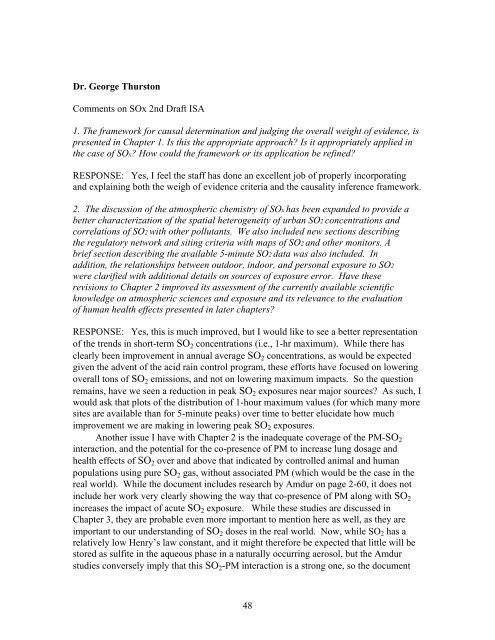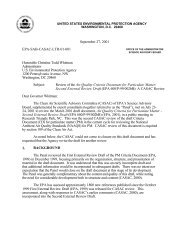(CASAC) Peer Review of EPA's Integrated Science Assessment
(CASAC) Peer Review of EPA's Integrated Science Assessment
(CASAC) Peer Review of EPA's Integrated Science Assessment
Create successful ePaper yourself
Turn your PDF publications into a flip-book with our unique Google optimized e-Paper software.
Dr. George ThurstonComments on SOx 2nd Draft ISA1. The framework for causal determination and judging the overall weight <strong>of</strong> evidence, ispresented in Chapter 1. Is this the appropriate approach? Is it appropriately applied inthe case <strong>of</strong> SOx? How could the framework or its application be refined?RESPONSE: Yes, I feel the staff has done an excellent job <strong>of</strong> properly incorporatingand explaining both the weigh <strong>of</strong> evidence criteria and the causality inference framework.2. The discussion <strong>of</strong> the atmospheric chemistry <strong>of</strong> SOx has been expanded to provide abetter characterization <strong>of</strong> the spatial heterogeneity <strong>of</strong> urban SO2 concentrations andcorrelations <strong>of</strong> SO2 with other pollutants. We also included new sections describingthe regulatory network and siting criteria with maps <strong>of</strong> SO2 and other monitors. Abrief section describing the available 5-minute SO2 data was also included. Inaddition, the relationships between outdoor, indoor, and personal exposure to SO2were clarified with additional details on sources <strong>of</strong> exposure error. Have theserevisions to Chapter 2 improved its assessment <strong>of</strong> the currently available scientificknowledge on atmospheric sciences and exposure and its relevance to the evaluation<strong>of</strong> human health effects presented in later chapters?RESPONSE: Yes, this is much improved, but I would like to see a better representation<strong>of</strong> the trends in short-term SO 2 concentrations (i.e., 1-hr maximum). While there hasclearly been improvement in annual average SO 2 concentrations, as would be expectedgiven the advent <strong>of</strong> the acid rain control program, these efforts have focused on loweringoverall tons <strong>of</strong> SO 2 emissions, and not on lowering maximum impacts. So the questionremains, have we seen a reduction in peak SO 2 exposures near major sources? As such, Iwould ask that plots <strong>of</strong> the distribution <strong>of</strong> 1-hour maximum values (for which many moresites are available than for 5-minute peaks) over time to better elucidate how muchimprovement we are making in lowering peak SO 2 exposures.Another issue I have with Chapter 2 is the inadequate coverage <strong>of</strong> the PM-SO 2interaction, and the potential for the co-presence <strong>of</strong> PM to increase lung dosage andhealth effects <strong>of</strong> SO 2 over and above that indicated by controlled animal and humanpopulations using pure SO 2 gas, without associated PM (which would be the case in thereal world). While the document includes research by Amdur on page 2-60, it does notinclude her work very clearly showing the way that co-presence <strong>of</strong> PM along with SO 2increases the impact <strong>of</strong> acute SO 2 exposure. While these studies are discussed inChapter 3, they are probable even more important to mention here as well, as they areimportant to our understanding <strong>of</strong> SO 2 doses in the real world. Now, while SO 2 has arelatively low Henry’s law constant, and it might therefore be expected that little will bestored as sulfite in the aqueous phase in a naturally occurring aerosol, but the Amdurstudies conversely imply that this SO 2 -PM interaction is a strong one, so the document48
















